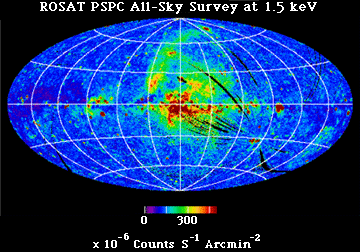First All-Sky maps of the ROSAT Soft X-ray Diffuse
Background Survey
The first all-sky maps from the ROSAT survey of the diffuse X-ray
background have been released by the Max Planck Institute for
Extraterrestrial Physics in Garching, Germany. The maps cover
approximately 98 % of the sky in the 1/4 keV, 3/4 keV, and 1.5 keV bands,
with an angular resolution of about 2 degrees and high sensitivity for low
surface brightness extended features. The effects of non-X-ray
contamination and X-rays of solar system origin have been eliminated to
the greatest possible extent, but discrete X-ray sources have not been
removed. The much improved angular resolution, statistical precision,
and completeness of coverage of these maps reveals considerable structure
over the entire 0.1 - 2.0 keV energy range that was not observed previously.
The data compare well with previous all-sky surveys in terms of absolute
normalization and zero point.
The maps were constructed using an equal-area (Aitoff-Hammer) projection.
Intensities are in units 10-6 counts/second/arcmin2.
The projections are in Galactic coordinates centered at 0 longitude with
longitude increasing to the left.

|
Figure 1. 1/4 keV diffuse background map from the ROSAT all-sky survey.
The projection is an Aitoff-Hammer equal-area in galactic coordinates
with the Galactic center in the middle. The image shows the general
increase in intensity from the Galactic plane to the poles, but it also
shows considerable detailed structure never before observed in this
energy range.
|
| Credit: The Max Planck Institute for Extraterrestrial Physics, Snowden
et al. 1995, ApJ, 454, 643 |

|
Figure 2. Map of the column density of Galactic neutral hydrogen in the
same projection as Figure 1. Note the general negative correlation
between the 1/4 keV diffuse X-ray background of Figure 1 and the
neutral hydrogen column density of Figure 2.
|
| Credit: Dickey and Lockman 1990, ARAA, 28, 215 |

|
Figure 3. 3/4 keV diffuse background map from the ROSAT all-sky survey
in the same projection as Figure 1. The image shows a radically
different structure than the 1/4 keV background of Figure 1. At
3/4 keV, the sky is dominated by the relatively smooth extragalactic
background and a limited number of bright extended Galactic
objects.
|
| Credit: The Max Planck Institute for Extraterrestrial Physics, Snowden
et al. 1995, ApJ, 454, 643 |

|
Figure 4. ROSAT 1.5 keV band map. This image of the X-ray sky is
similar to the 3/4 keV map except that the Galactic contribution is
reduced.
|
| Credit: S.L. Snowden et al. 1995, The Astrophysical Journal,
Vol. 454, pp. 643-653 and MPE |





